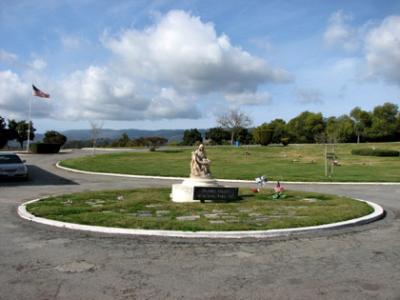
Road Trip, Part 3: More Cemetery Tour

After my cousins Charlotte and Nancy and I finished visiting the Pioneer Cemetery in Watsonville, we headed out to the Pajaro Valley Memorial Cemetery to pay our respects to our grand parents, Percy and Lyllian.
When I was a child, we used to go out and place flowers on Lyllian’s grave. She died in 1938. After her passing, Grandpa took solace in the brothels of Watsonville.
Everyone disliked his last wife, and my mother would mutter about her, "That old madam." I didn’t realize until years later that it wasn’t merely my mother being nasty - in fact, Grandpa’s last wife had been a madam.
We were not close to Madam. She did not care for children. She drove a Cadillac convertible, had rhinestones on her glasses frames, and kept yappy little poodles and Siamese cats. I do not wish to impugn these animals, some of whom were friendly and fun, unlike Madam. After Grandpa died Madam married a man with Las Vegas connections. He died a few years later when he started his car one day and it blew up. In retrospect, we are glad we never were close to Madam.
When my grandfather died in 1961, the preacher speaking at his service said, "Percy lived a full life." There was a wave of laughter. At the time I was too young understand that reaction, but later I heard the stories about Grandpa.
Percy is buried next to Lyllian, his first wife and our grandmother. There is an empty space in the cemetery lawn on the other side of Percy, and cousin Charlotte went to the cemetery office to inquire about that space because she wishes to be buried there.
While Charlotte was in the office, I decided to pursue a question of my own. Once when I was a child I accompanied my mother’s sister out to the cemetery to leave flowers at various graves, and as we were leaving my aunt pointed at a circular area and said, "That’s where your mother buried that baby she lost."
Say what?
I went home and asked my mother about that baby. She angrily said she had told me about it. If she did I did not remember.
In later years she talked about it a little. She was almost nine months pregnant, standing at the kitchen window looking out. She felt the baby move inside of her, like it was turning over, and that was the last time she felt it move. It was stillborn soon after, a little girl, and buried in an unmarked grave in that circle of grass. That was in 1946.
There is nothing like finding out you have a dead sibling to set your imagination going. If she had lived, would I have been born? If we had both been born, wouldn’t it have been great having a sister? My friends who have sisters tell me, "Not necessarily."
The lady at the cemetery office found my father’s name typed on a 3x5 index card, and walked out to the circular area with a plot map. Waving her hand in the general area of some grass she said, "Right there."
There she lies, the sister who never took breath. When my mother was still alive, I asked if she knew why the baby died. "Women lost babies a lot in those days," she said, waving me off.
I stared at the patch of grass. She is surrounded by the remains of other people, some of whom were also infants. I’m not sure why finding her grave had so much meaning to me or even what that meaning was, but it felt deep.
That was the last stop on the cemetery tour. Cousins Nancy and Charlotte wrote to me after I got home that there are more ancestors in a cemetery in Manteca, California. Maybe some day I’ll get there. For now visiting the two cemeteries in Watsonville was enough of a family pilgrimage for me.
- Login to post comments
